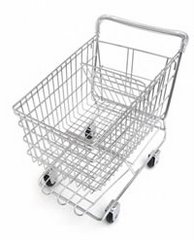Visibility of system status
Margaret is not used to having information bombarded at her on a computer screen and liked the fact that the display was simple and clear. She found the colours used and components easy to distinguish between.
Match between system and the real world
Margaret was able to identify the supermarket arrangement and navigate it as she would normally. She had a good idea of which area of the supermarket a product would be located. She browsing fairly straight forward once she had gotten used to the control system. Margaret was able to estimate where a required product was on the shelves by looking at the different isles and the types of foods in a certain area, much the same as when browsing in real life.
User control and freedom
In a few instances Margaret found herself selecting the wrong button and arriving at the wrong screen. In every case Margaret used the back button and found herself back at the previous screen which she could always see anyway due to the previous screen always being greyed out and the new layer displayed over the top. She admitted that without the back button she would have been stuck on several occasions.
Margaret found she was free to move around the supermarket at will and was not restricted. In one occasion she found herself stuck in a corner but by using intuition and the natural operation of the controls managed to easily free herself.
Consistency and standards
As the system is more visually orientated there is little written text. Margaret found that always understood although there was one occasion where the items she was about to purchase were referred to as her shopping cart which threw her a little as she was unaware of the term.
Compared to any computer system that Margaret has previously used, this was very different so the standards that she was used to for existing programs did not apply.
Error prevention
As mentioned before the instances where Margaret went to the wrong page, she always had the back button to rely on which got her out of the problem.
Margaret found that due to the simplicity of the system she didn’t often make mistakes as there were few instances where a mistake was possible.
One of the main problems she found is that if she accidentally added the wrong item to her basket, it was immediately clear how to undo this error and it took Margaret a while to sort out the problem. She did say that if she was by herself that she would have been unsure how to resolve the problem and would either have spent a long time running round in circles or have just given up all together.
Recognition rather than recall
Margaret very much liked the fact that in every screen, it was clear what task each button performed. By the end on the session she was looking at the text on the button far less and just recognising that the colours of the buttons performed operations that she was expecting.
Margaret did point out that often when she was half way down an isle she forgot where about in the isle she was and sometimes couldn’t work out where another isle would be in relation to her current position.
Margaret found when using the main menu that she did not know the difference between new shop and old shop and which she should use and what situation she should use them in.
Flexibility and efficiency of use
She didn't find the buttons flexible as there is only certain amount of operation that can be performed with 4 buttons at a given time but this adds to the efficiency as only relevant options are ever shown or required. This leads to the simplicity which she enjoyed.
Aesthetic and minimalist design
Margaret found the design of the layout very simple. She thought that menus only had few options at a time and she was never to overwhelmed with information. If she found that there were to many slide menu’s, for example if the shopping list and information list were both open, that she could close them easily, creating more space for her navigation.
Margaret liked the fact that when she first selected an item on the shelf, when the ‘Product Selection’ screen appeared, she was given a brief summary of each information field rather than all of the information at once.
Help users recognize, diagnose, and recover from errors
During the use of the system Margaret did not receive any error messages. She rather like this fact as she felt that she was using the system properly. The fact of the matter is that there are very few instances where an error message is actually displayed due to the design and flow of the screens.
Help and documentation
Margaret found the help videos useful and found that they taught her how to use the system perfectly fine. She did however have trouble finding information when she reached a specific problem. She found that she had to watch a whole video hoping that the issue would be covered. If it was not then she had to keep trying until she found it.
Margaret like the idea of the video help but would prefer more written information to be available to back it up.

No comments:
Post a Comment